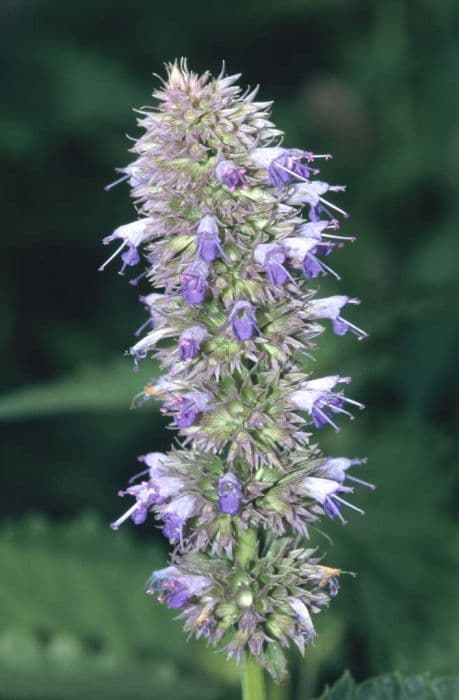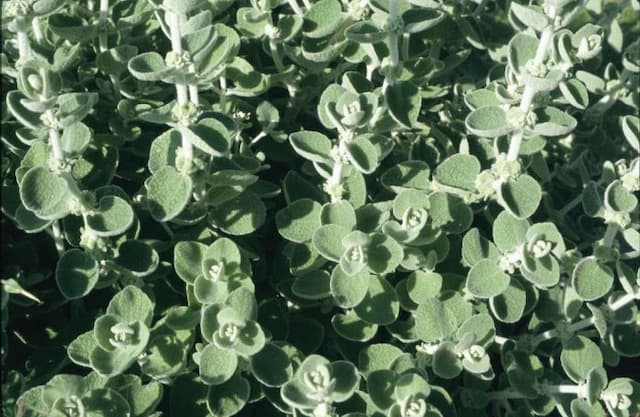Lake Sevan Catmint Nepeta nuda 'Lake Sevan'

ABOUT
Lake Sevan is a variety of catmint that possesses a unique and attractive appearance. This perennial plant features a bushy and somewhat relaxed growth habit, with numerous branches stemming from the base. The foliage of Lake Sevan catmint is an enchanting gray-green color, and the leaves are characterized by their hairy texture which gives them a soft, plush feel when touched. The leaves are typically small and heart-shaped, with a crinkled edge that adds textural interest to the plant's overall look. During its blooming season, Lake Sevan catmint produces striking flower spikes that tower above the foliage. The flowers are small but numerous, creating a dense, frothy effect. They are typically of a pale lavender to purple hue, which contrasts beautifully with the silvery tones of the foliage. The flowers are tubular and form whorls around the spike. These blooms are not only aesthetically pleasing but are also known to attract various pollinators such as bees, butterflies, and hummingbirds, adding to the liveliness of any garden space. Lake Sevan catmint's appearance is one of casual elegance, making it a popular choice for gardeners looking to add a touch of whimsy and charm to their landscape without the need for a rigid, formal garden structure. It's known for its aromatic leaves which, when brushed against or crushed, release a pleasant aroma that is quintessential of the mint family. The fragrance is not only enjoyed by humans but also tends to be repellent to certain pests, contributing to the plant's attractiveness as a garden addition.
About this plant
 Names
NamesSynonyms
Lake Sevan Catmint, Bald Nepeta.
Common names
Nepeta nuda.
 Toxicity
ToxicityTo humans
Lake Sevan Catmint is not commonly known to be toxic to humans. In general, members of the Nepeta genus are not associated with serious health risks when ingested in small quantities. However, as with many plants, it is possible that some individuals may experience mild digestive upset or allergic reactions if they consume parts of the plant, especially in larger quantities.
To pets
Lake Sevan Catmint is typically not toxic to pets. In fact, plants in the Nepeta genus, which include catmint and catnip, are well-known for their behavioral effects on cats, who may enjoy the plants' mild stimulant effects. Nevertheless, while not considered poisonous, consuming large amounts might still cause mild gastrointestinal symptoms in pets, such as vomiting or diarrhea, especially in animals that are not accustomed to ingesting plant material.
 Characteristics
CharacteristicsLife cycle
Perennials
Foliage type
Deciduous
Color of leaves
Green
Flower color
Blue
Height
2 feet (0.61 meters)
Spread
2 feet (0.61 meters)
Plant type
Herb
Hardiness zones
5
Native area
Caucasus
Benefits
 General Benefits
General Benefits- Ornamental appeal: Nepeta nuda 'Lake Sevan', commonly known as Catmint, displays attractive, lavender-blue flowers that add aesthetic beauty to gardens.
- Drought tolerance: Catmint is known for being drought-resistant, which makes it an excellent choice for water-wise landscapes.
- Attracts pollinators: The flowers of Catmint are enticing to bees, butterflies, and other beneficial pollinators, enhancing biodiversity.
- Low maintenance: Catmint is generally easy to care for, requiring minimal upkeep once established.
- Deer and rabbit resistance: This plant is rarely eaten by deer and rabbits, making it a suitable option for gardens prone to these visitors.
- Herbaceous perennial: As a perennial, Catmint comes back year after year, reducing the need for replanting.
- Fragrant foliage: The leaves of Catmint release a pleasant fragrance when crushed or brushed against, contributing to a sensory garden experience.
- Erosion control: The dense growth habit of Catmint can help in stabilizing soil and preventing erosion on slopes.
- Edging and border planting: Catmint's mounding habit makes it a good choice for use as edging plants or in borders.
- Companion planting: Catmint can be used effectively in companion planting to enhance the growth of other plants and deter pests.
 Medical Properties
Medical PropertiesThis plant is not used for medical purposes.
 Air-purifying Qualities
Air-purifying QualitiesThis plant is not specifically known for air purifying qualities.
 Other Uses
Other Uses- Cat Attraction – Like many plants in the Nepeta genus, Lake Sevan is attractive to cats, who may enjoy rubbing against it or rolling in it due to its mild sedative effect on them.
- Garden Design – Its lavender-like flowers and attractive foliage make it a popular choice for ornamental purposes in gardens and landscape designs.
- Companion Planting – Lake Sevan can be planted alongside vegetables in a garden to help repel certain insects and pests due to its aromatic leaves.
- Natural Dye – The plant can be used to create a natural dye for fabrics, yielding a color that typically ranges from a light yellow to greenish hue.
- Erosion Control – Its ability to grow in poor soil and spread quickly makes it useful for controlling soil erosion on banks and slopes.
- Agricultural Benefits – When planted in crop areas, Lake Sevan can attract beneficial insects that prey on pests harmful to crops.
- Culinary Garnish – Although not commonly used for culinary purposes, the flowers and young shoots can be edible and used as a garnish for salads and other dishes.
- Floral Arrangements – Fresh or dried flowers from Lake Sevan can be used in floral arrangements for their color and form.
- Wildlife Habitat – The plant can provide a habitat for wildlife, especially for insects and certain birds that feed on the seeds or take cover in its foliage.
- Arts and Crafts – Dried stems and flowers of Lake Sevan can be incorporated into arts and crafts projects, such as wreaths or potpourri.
Interesting Facts
 Feng Shui
Feng ShuiThe Catmint is not used in Feng Shui practice.
 Zodiac Sign Compitability
Zodiac Sign CompitabilityThe Catmint is not used in astrology practice.
 Plant Symbolism
Plant Symbolism- Tranquility: Related to the calming influence of catnip, Nepeta nuda 'Lake Sevan' is often associated with peace and relaxation.
- Happiness: The plant’s ability to stimulate cats is transferred symbolically to humans, suggesting the bringing of joy and happiness.
- Invisibility: In folklore, it's sometimes believed that catnip can render one invisible, symbolically implying protection or evasion from unwanted attention.
- Love: The attraction that cats have towards this plant is symbolically extended to mean the attraction between people, it can represent love and passion.
- Healing: Traditionally used for medicinal purposes, the plant embodies the concept of healing and wellness.
 Water
WaterThe common name for Nepeta nuda 'Lake Sevan' is Balkan Catmint. Balkan Catmint prefers to be watered when the top inch of soil feels dry to the touch. It's advisable to water the plant deeply, ensuring the water reaches the roots rather than just wetting the surface. Typically, this could mean providing about 1 to 1.5 gallons of water every week during the growing season, but the frequency may decrease during cooler months or in periods of rain. Always avoid overwatering by allowing the soil to dry out between waterings, and ensure proper drainage to prevent root rot.
 Light
LightBalkan Catmint thrives in full sun conditions, which means it requires at least 6 to 8 hours of direct sunlight daily. The best spot for Balkan Catmint would be an area where it can receive unobstructed sun throughout most of the day, such as a south-facing garden bed. While it can tolerate some light shade, too little sunlight can lead to leggy growth and fewer blooms.
 Temperature
TemperatureBalkan Catmint can tolerate a wide range of temperatures, but it grows best in conditions between 60°F to 80°F. It can survive minimum temperatures down to about -30°F, making it hardy in many regions. During extremely hot summer days over 90°F, some additional shade and water might be needed to keep the plant healthy.
 Pruning
PruningPruning Balkan Catmint is important to encourage more compact growth and repeat blooming. It's recommended to prune in the spring to remove any dead or damaged growth from the winter. Additionally, after the first flush of flowers fades, give the plant a light trim to promote a second flush of blooms. Pruning should be done every few weeks during the growing season to keep the plant tidy and full.
 Cleaning
CleaningNot needed
 Soil
SoilCatmint 'Lake Sevan' prefers a well-draining, loamy or sandy soil with a pH range from 6.0 to 7.5. A soil mix with one part garden soil, one part sand or perlite, and one part compost or well-rotted manure will support healthy growth.
 Repotting
RepottingCatmint 'Lake Sevan' typically doesn't need frequent repotting and can be done every 2 to 3 years or when it outgrows its current container.
 Humidity & Misting
Humidity & MistingCatmint 'Lake Sevan' thrives in average humidity levels and does not require any special humidity considerations; it's quite adaptable to typical outdoor conditions.
 Suitable locations
Suitable locationsIndoor
Ensure well-draining soil, sunny spot, and infrequent watering for Catmint 'Lake Sevan'.
Outdoor
Plant in full sun, well-draining soil, and water occasionally for Catmint 'Lake Sevan'.
Hardiness zone
4-8 USDA
 Life cycle
Life cycleThe life of 'Lake Sevan' Catmint (Nepeta nuda 'Lake Sevan') begins with seed germination, typically occurring in spring when soil temperatures warm up. Following germination, seedlings establish a root system and produce their first true leaves, entering the vegetative growth phase. This perennial then undergoes a period of rapid foliage expansion and stem elongation in preparation for the reproductive stage. Flower buds develop, leading to full bloom in late spring or early summer when the plant displays its characteristic lavender-blue flowers that attract pollinators. After pollination, seeds form and mature, completing the reproductive cycle, while the plant itself may enter a period of dormancy in the winter, especially in colder climates. With the return of favorable conditions in the following spring, 'Lake Sevan' Catmint resumes growth from its rootstock, repeating this cycle annually.
 Propogation
PropogationPropogation time
Spring-Early Summer
The most popular method for propagating Nepeta nuda 'Lake Sevan', commonly known as catmint, is through stem cuttings. This is typically done in the spring or early summer when the plant is actively growing. To propagate, a gardener would take a 4 to 6-inch cutting (approximately 10 to 15 cm) from the tip of a healthy stem, strip the leaves from the lower half, and dip the cut end into rooting hormone powder. The cutting is then planted in a moist, well-draining soil mixture. Within a few weeks, the cutting should develop roots and can then be transplanted into the garden. It's important to keep the soil consistently moist but not waterlogged during the rooting period to ensure successful propagation.









